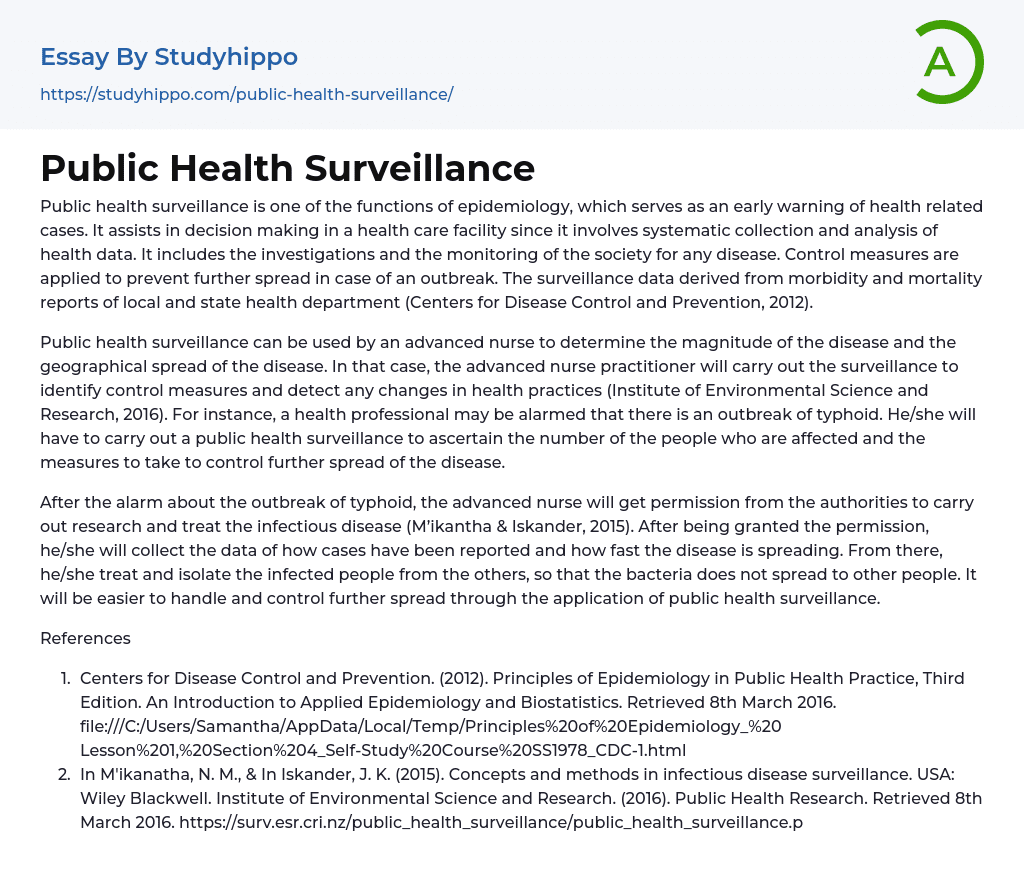Public health surveillance is one of the functions of epidemiology, which serves as an early warning of health related cases. It assists in decision making in a health care facility since it involves systematic collection and analysis of health data. It includes the investigations and the monitoring of the society for any disease. Control measures are applied to prevent further spread in case of an outbreak. The surveillance data derived from morbidity and mortality reports of local and state health department (Centers for Disease Control and Prevention, 2012).
Public health surveillance can be used by an advanced nurse to determine the magnitude of the disease and the geographical spread of the disease. In that case, the advanced nurse practitioner will carry out the surveillance to identify control measures and detect any changes in health practices (
...Institute of Environmental Science and Research, 2016). For instance, a health professional may be alarmed that there is an outbreak of typhoid. He/she will have to carry out a public health surveillance to ascertain the number of the people who are affected and the measures to take to control further spread of the disease.
After the alarm about the outbreak of typhoid, the advanced nurse will get permission from the authorities to carry out research and treat the infectious disease (M’ikantha & Iskander, 2015). After being granted the permission, he/she will collect the data of how cases have been reported and how fast the disease is spreading. From there, he/she treat and isolate the infected people from the others, so that the bacteria does not spread to other people. It will be easier to handle and control further spread through the applicatio
of public health surveillance.
References
- Centers for Disease Control and Prevention. (2012). Principles of Epidemiology in Public Health Practice, Third Edition. An Introduction to Applied Epidemiology and Biostatistics. Retrieved 8th March 2016. file:///C:/Users/Samantha/AppData/Local/Temp/Principles%20of%20Epidemiology_%20
Lesson%201,%20Section%204_Self-Study%20Course%20SS1978_CDC-1.html - In M'ikanatha, N. M., & In Iskander, J. K. (2015). Concepts and methods in infectious disease surveillance. USA: Wiley Blackwell. Institute of Environmental Science and Research. (2016). Public Health Research. Retrieved 8th March 2016. https://surv.esr.cri.nz/public_health_surveillance/public_health_surveillance.php
- Social Care essays
- Epidemiology essays
- Drug Addiction essays
- Hiv essays
- Hygiene essays
- Obesity essays
- Teenage Pregnancy essays
- Birth Control essays
- Eating Disorders essays
- Causes Of Obesity essays
- Children Obesity essays
- Addiction essays
- Anatomy and Physiology essays
- Biodegradation essays
- Cancer essays
- Dental Care essays
- Disability essays
- Disease essays
- Disorders essays
- Health Care essays
- Infectious Disease essays
- Inquiry essays
- Intelligence Quotient essays
- Lung Cancer essays
- Medicine essays
- Neurology essays
- Nutrition essays
- Olfaction essays
- Physical Exercise essays
- Public Health essays
- Sex essays
- Women's Health essays
- World health organization essays
- Animal Cruelty essays
- Charles Manson essays
- Crime Prevention essays
- Crime scene essays
- Criminal Justice essays
- Criminology essays
- Cyber Crime essays
- Damages essays
- Detention essays
- Distracted Driving essays
- Drug Trafficking essays
- Drunk Driving essays
- Forensic Science essays
- Gang essays
- Hate Crime essays
- Homicide essays
- Identity Theft essays




